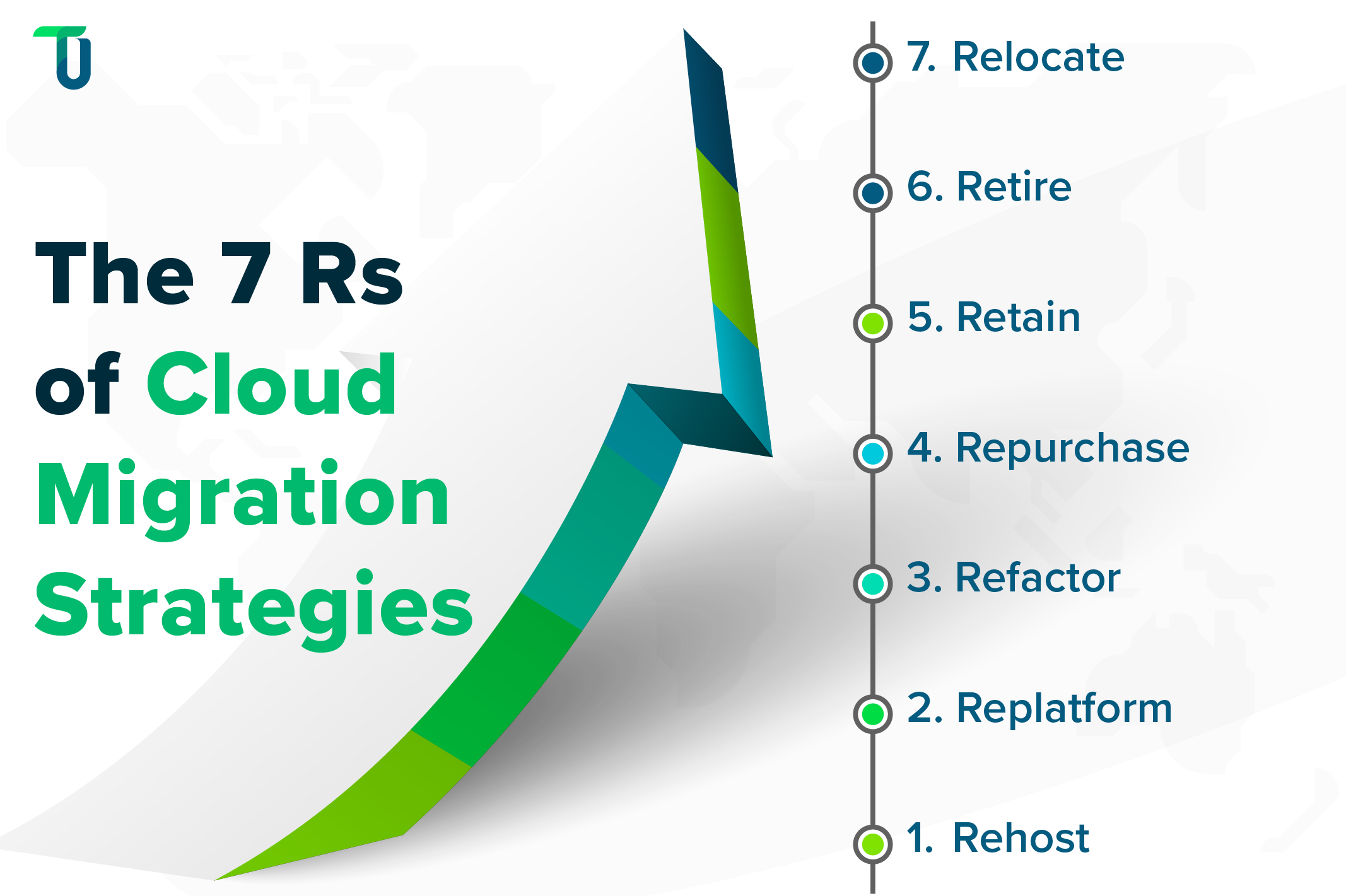What is Application Migration in the Cloud?
Application migration in the cloud is when software moves from in-house servers to a cloud system. It helps businesses become more flexible, cost-efficient, and scalable. With cloud computing, companies can serve more users, adapt faster, and spend less on physical infrastructure.
Companies don't always start over. Instead, they use strategies like:
Rehosting: Move apps without changing them (lift-and-shift).
Replatforming: Make small changes for better cloud performance.
Refactoring: Revamp code to use all cloud features.
In short, cloud migration helps businesses stay modern, reduce downtime, and remain competitive in a digital world powered by cloud technology.
Did You Know? 94% of enterprises already use cloud services, and 87% have a multi-cloud strategy, according to Flexera’s 2023 State of the Cloud Report.
Key Strategies for Cloud Migration: The 7 Rs
Cloud migration has 7 major strategies, known as the 7 Rs. Here’s a breakdown of each one and how they benefit cloud migrations.

Rehost (Lift and Shift)
Rehosting, also called "lift and shift," is a quick way to move apps to the cloud. It involves transferring existing apps from on-premises servers to the cloud without changing how they work. It’s an easy way to enjoy the cloud’s benefits without redesigning everything.
When to Use Rehost:
Quick Migration: If you need to move fast and don’t want to spend time reworking your apps, rehosting is ideal. It allows you to take advantage of the cloud almost immediately.
Cost Savings: You will save on maintaining physical servers since the workload moves to the cloud.
Stable Apps: If your apps are working fine, you can move them to the cloud without major changes.
For example, a company might move its old customer management system to the cloud, cutting maintenance costs while keeping everything running as before.
Pro Tip: Start by rehosting less critical apps first. This lets your team learn the process before moving important systems.
| Pros | Cons |
|---|---|
| Fast migration with low initial costs | Doesn’t fully tap into cloud-native features. |
| Reduces costs by eliminating infrastructure maintenance. | May have performance issues because older systems aren't optimized. |
| Keeps core functions intact, so business runs smoothly. |
Replatform (Lift, Tinker, and Shift)
Replatforming is a more advanced version of rehosting. You move your apps to the cloud while making minor tweaks to improve their performance. You don’t need a complete rebuild—just small changes that make your apps run better in the cloud.
When to Use Replatform:
Better Performance: If you want better performance or savings, replatforming is the way to go. You can upgrade databases or switch to cloud-managed services.
Leverage Cloud Services: Replatforming allows you to use cloud features like managed databases and storage, optimizing your system.
Modernize Without Overhauling: If you want improvements but not a total redesign, replatforming offers a quicker way to modernize.
For example, an online store might move its platform to the cloud while switching to a managed database service. This boosts scalability and reliability without rebuilding everything.
| Pros | Cons |
|---|---|
| Improves performance and scalability using cloud features. | Might have integration challenges with cloud-native services. |
| Reduces operational work with managed services. | Staff may need extra training to manage the new services. |
| Less risky than a full redevelopment. |
Expert Advice: When replatforming, focus on easy wins like upgrading databases or adopting managed services. This makes the migration smoother and shows results quickly.
Refactor (Re-architect)
Refactoring, sometimes referred to as re-architecting, entails completely re-engineering an application to fully leverage cloud migration strategies and cloud-native capabilities. This approach is suitable for applications that require substantial rework in order to gain greater performance, scalability, and agility in the cloud. This is more than just tweaks: it's about bringing the app up to date for the best cloud experience possible.
When to Use Refactor:
Maximize Cloud Benefits: If you want to unlock the full potential of the cloud—such as automatic scaling, resilience, and flexibility—refactoring is the right approach.
Outdated Applications: When your applications are outdated and can’t meet the growing demands of your business, refactoring ensures they are rebuilt to stay relevant and effective.
Innovate with Cloud Features: If you aim to integrate advanced cloud technologies like microservices, serverless computing, or containerization, refactoring will allow you to take advantage of these powerful features.
For instance, a company that provides financial services might house a legacy trading application unable to keep pace with rapid changes in the marketplace. It would make it more agile and rapid by refactoring it into finer-grained bits (microservices) and adaptive technologies (serverless computing, containers).
| Pros | Cons |
|---|---|
| Leverages the full potential of cloud for better performance and scalability. | Requires significant time, resources, and costs to complete. |
| Aligns with modern development practices like continuous integration and continuous delivery (CI/CD). | Potential disruption to normal operations during the transition. |
| Encourages innovation and rapid deployment of new features. | Demands specialized expertise in cloud-native development. |
Let Us Help You Choose the Right Cloud Strategy
Don’t guess your way through cloud migration. Get a free consultation with our experts to determine which “R” fits your business needs best!
Repurchase
Repurchase means replacing an existing application with a cloud-native version, often through a SaaS approach. In order to demonstrate this approach to be effective, your business is no longer practically usable with a specific application, or cloud-based solutions that are feature-rich, scalable, and functional.
When to Use Repurchase:
Outdated Applications: If your current software is old or lacks important features, it might be time to replace it with a cloud-native SaaS option that provides more value.
Reduce Maintenance Costs: Cloud-based applications are often fully managed, meaning they handle infrastructure, updates, and support, reducing the maintenance burden on your team.
Standardization: Repurchasing allows you to standardize your systems and implement modern, cloud-based solutions that streamline and simplify operations.
For instance, a company that utilizes an on-premises human resources management system (HRMS) might choose to later adopt a cloud-based HR platform. One feature of the new platform can be advanced analytics, intuitive user interface, and increased scalability without the need for capital expenditure on infrastructure maintenance.
TenUp's Take: Before switching to a SaaS product, check for integration capabilities with your existing systems. It will save you time and effort during onboarding.
| Pros | Cons |
|---|---|
| Access to the latest features with regular updates. | Data migration can be challenging and may take time. |
| No need to manage infrastructure or handle updates. | There might be a learning curve as employees adjust to the new system. |
| Scalable and flexible, adapting to the company’s growth and needs. | Reliance on the vendor for uptime and customer support. |
Retain
In some cases, businesses may decide to keep certain applications on their own premises, either temporarily or permanently. This approach, known as retention, is often used for applications that have specific needs, such as compliance, performance, or strategic reasons, that may not be fully supported by the cloud. Retaining applications gives organizations more control over their most critical systems.
When to Use Retain
Compliance Needs: Some industries, like healthcare or finance, are bound by strict data protection laws that require sensitive information to stay on-premises instead of being stored in the cloud.
Performance Demands: If an application needs super-fast performance with minimal delay, and the cloud can't guarantee this level of speed, keeping it on-premises may be the best option.
Cost of Migration: Moving an application to the cloud can be costly. If the benefits of cloud migration don't outweigh the cost, it may make more sense to leave it where it is.
For example, a government agency may need to keep its legacy database on-premises because of strict data privacy laws that prevent sensitive information from being stored in the cloud.
| Pros | Cons |
|---|---|
| Complete control over your data and systems. | Higher ongoing maintenance and infrastructure costs. |
| Avoids the complexity of migrating systems. | Limited ability to scale and adapt quickly compared to cloud solutions. |
| Fewer risks in maintaining legacy systems. |
Retire
When you retire applications it means you stop using them entirely, typically when the applications become obsolete or redundant. In fact, studies show that 20-30% of enterprise applications are redundant or seldom used. Eliminating unused or outdated apps can not only help your systems run more smoothly but also lower cost and provide better performance in total.
When to Use Retire:
Outdated Systems: If an application no longer meets requirements, or a newer system has proven to be more efficient, the old one must be discontinued.
No Feasible Migration Path: Sometimes migrating or keeping an old system in place simply isn’t viable. If investing time or resources to upgrade it doesn’t make sense, retiring it may the optimal solution.
For example, a retail company chooses to retire its outdated inventory management system after adopting a cloud-based platform with better forecasting tools and real-time data analysis capabilities.
| Pros | Cons |
|---|---|
| Optimizes your IT environment, reducing reliance on outdated technology. | Requires careful handling of data to ensure it’s archived correctly and securely. |
| Saves money by cutting down on maintenance and infrastructure costs. | Risk of losing important historical data if not properly managed during the transition. |
Relocate
Application relocation also refers to the process of moving applications from one cloud environment to another, or even from on-premises systems to the cloud. If you want to optimize your existing cloud infrastructure or make sure your service offerings are more closely aligned with your business requirements, this approach is very useful.
When to Use Relocate:
- Cloud Optimization: If you need to utilize another cloud provider has better pricing, performance, or new features.
- Platform Migration: For moving from on-premises systems to the cloud, or from one cloud provider to another to optimize your resources.
Quick Tip: Test compatibility with the new cloud provider in a sandbox environment before full relocation. This helps prevent major surprises during go-live.
For example, a large corporation decides to relocate its enterprise resource planning (ERP) system from one cloud service provider to another after realizing that the new provider offers more affordable costs and better storage options.
| Pros | Cons |
|---|---|
| Can help save costs by selecting a more competitive cloud provider. | The migration process can be complex, and there may be disruptions. |
| Provides better scalability and flexibility with the new cloud infrastructure. | Compatibility issues can occur when applications are moved to a new cloud platform. |
These are the 7 cloud migration strategies. Each has its own advantages and disadvantages, as we can see. You need to plan your business needs and select an appropriate strategy that helps execute a smooth migration while also achieving your business targets.
Navigate Cloud Migration Confidently with TenUp
Cloud migration is a must for businesses looking to stay ahead. It offers greater flexibility, scalability, and cost savings. Additionally, the 7 different strategies—rehost, re-platform, refactor, repurchase, retain, retire, and relocate—empower you to choose the best approach for your unique business needs.
However, to truly make the most of these benefits, you need more than just a cloud solution. You need a trusted partner to guide them through the process and ensure a smooth transition.
That’s where TenUp comes in. We offer expert support and tailored cloud migration services to help you transition with ease. Get in touch with our experts today to learn more about our cloud migration solutions.
Achieve Successful Cloud Migration
The right strategy and flawless implementation make all the difference. Let TenUp help you plan and execute your cloud migration successfully.
Frequently asked questions
How do I determine the best 'R' cloud migration strategy for each of my applications?
Before migrating to the cloud, assess each app’s architecture, business value, technical debt, and future needs. Use tools like AWS Migration Hub or Azure Migrate to map the optimal strategy, whether it is Rehost, Refactor, or others, based on scalability, cost, and effort.
What are the cost implications of each of the 7 Rs of cloud migration strategies?
Each migration strategy has distinct cost considerations. For instance, 'Rehosting' might incur lower initial costs but could lead to higher long-term expenses due to suboptimal resource utilization. Conversely, 'Refactoring' demands more upfront investment but can offer better cost efficiency over time.
Can multiple 'R' strategies be applied within a single migration project?
Yes, most cloud migration projects use a mix of strategies. Each application or service may have different requirements, so combining approaches, like rehosting stable apps and refactoring complex ones, lets you balance speed, cost, and long-term value.
What challenges might arise when implementing multiple 'R' cloud migration strategies simultaneously?
Applying different cloud migration strategies at once can create challenges like resource conflicts, varied tool requirements, and inconsistent project timelines. Managing this complexity requires strong coordination, defined ownership for each strategy, and adaptable planning to ensure smooth execution across teams.
What tools are available to assist in choosing the right migration strategy?
Cloud providers offer various tools to aid in migration planning. For example, AWS provides the Migration Evaluator and Migration Hub, while Microsoft offers Azure Migrate. These tools help assess workloads and recommend suitable migration strategies.
How do I handle applications that don't neatly fit into one of the 7 Rs categories?
Some applications may require a customized approach that blends elements from multiple cloud migration strategies. In such cases, conducting a thorough analysis of the application's architecture, dependencies, and business requirements is crucial to devise an effective plan.

